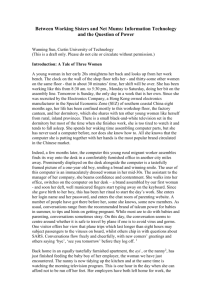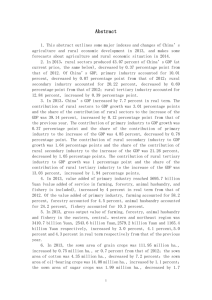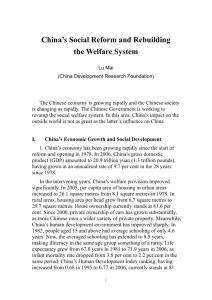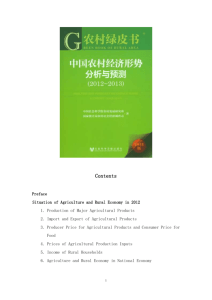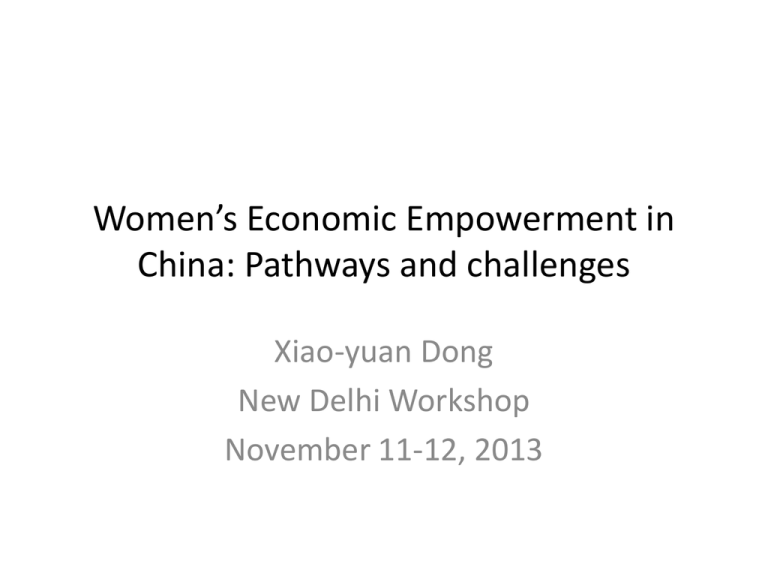
Women’s Economic Empowerment in
China: Pathways and challenges
Xiao-yuan Dong
New Delhi Workshop
November 11-12, 2013
Comparative Strengths and Common Challenges
• Devaki Jain:
Chinese women have apparently fared better than their sisters in India in
terms of health, education and economic opportunities, whereas women in
India are more active politically and have exerted a greater influence in the
policy process than do women in China.
• How can women in the two countries get both and move
forward both economically and politically?
• What can we learn from each other? And what common
challenges do we face for achieving gender equality?
Economic participation and opportunity
China
Labor force
participation (%)
India
Women
Men
W/M
Women
Men
W/M
74
85
0.88
35
85
0.42
Wage equality for
similar work
Estimated earned
income $PPP
0.66
6,592
10,156
Women’s share in wage
employment in nonagricultural sectors (%)
0.65
0.62
1,530
5,635
39
18
Legislators, officials and
managers (%)
17
83
0.20
NA
NA
Professional and
technical workers (%)
52
48
1.08
NA
NA
Source: World Economic Forum Gender Gap Index 2012
0.27
Education and health
China
India
Women
Men
W/M
Women
Men
W/M
Literacy rate (%)
91
97
0.94
51
75
0.68
Enrolment in primary
education (%)
97
96
1.01
92
93
0.99
Enrolment in secondary
education (%)
0.97
0.79
Enrolment in tertiary
education (%)
27
25
1.10
15
21
0.73
Healthy life expectancy
(years)
68
65
1.05
57
56
1.02
Maternal mortality
/100,000 live births
37
Source: World Economic Forum gender Gap Index 2012
200
Political empowerment
China
India
Women
Men
W/M
Women
Men
W/M
Women in parliament
(%)
21
79
0.27
11
89
0.12
Women in ministerial
positions (%)
12
88
0.13
10
90
0.11
Years with female head
of state (last 50 years)
4
46
0.08
19
31
0.61
In India, a 33-percent quota was set for women to lead the village councils in the 1990s
and the quota is now raised to 50 percent.
In China, women will account for 30 percent of the village committee members and 10
percent of the village leaders by 2020, according to China’s Women Development
Program (2010-2020).
Sex discrimination against women is still
pervasive in both countries
Source: World Values Survey Databank
Gender gap in survival and “missing
women”
China
India
Female-male ratio at birth
0.88
0.89
Female-male ratio in the population
0.926
0.937
At birth
644
184
0–5
132
310
5 – 19
1
170
20 – 39
75
248
40 – 64
166
234
65 +
709
566
Total (MW)
1,727
1,712
% female population
0.31
0.34
Excess female deaths by age (1,000) in 2000
Consequences of sex imbalance:
Violence against women, spread of STDs
Source: : U.S. Census Bureau, International Database.
Chinese women’s economic
empowerment: pathways and challenges
• The Socialist Legacy
• During Maoist era, the labor system was modeled in accordance
with the theory of Marx that social production is an integrated
process of the production of material products and the
reproduction of human being themselves.
• The socialist labor system minimized the market “penalties” that
women had to endure for their reproductive role.
• The socialist legacy fundamentally transformed traditional gender
relations and created favorable initial conditions for post-reform
economic take-off.
• However, the centrally planned system created huge inefficiencies
and redundancy and state supports were limited to urban workers.
• At the end of 1970s, the poverty rate in China was much higher
than that in India.
Poverty and Income inequality
in China and India
Source: World Bank Povalnet
• Economic transition (1978 onward):
• Shared poverty is not a characteristics of socialism.
• China is in the primary stage of socialism.
The priority:
Promote economic growth and improving people’s livelihood
(发展经济,改善民生)
The means:
Economic reforms and opening up to foreign trade and investment
• The long-term goals:
- Quadruple GDP by 2000
- Become a middle-income country by 2020 (the 100th anniversary of
the CCP)
- Become a developed country by 2050 (the 100th anniversary of the
PRC)
• 1978 – 1991: gradualist phase
- Replace the commune system by the household responsibility
system and develop township-village enterprises (TVEs)
- Decentralized economic decision making and provide incentives to
managers and workers of state-owned enterprises (SOEs)
- Set special economic zones
• 1992-2002: radical phrase
- “Grasp the large and let go of the small”
-
Privatization of TVEs
Public-sector restructuring, letting go of 25 million workers
Join the WTO in December 2001
The dismantling of local collective- and employers-based social
welfare systems led to a reversal of trends in poverty alleviation
and a sharp increase of inequalities, including gender inequalities.
2002-2012: Emergence of social policy
- Develop a people-centered, harmonious society
•
•
•
-
Two types of social policies
Reducing inequality
Regional disparity and urban/rural disparity
Increasing social security and labor protection
Minimum income allowance
Medical insurance
Old-age security
Public housing for urban poor
Minimum wages, collective bargaining, and other labor
regulations
2002-2012: Emergence of social policy
- Develop a people-centered, harmonious society
Year
New social policies and labor market policies
1999
Go west policy
2002
Urban minimum income guarantee program
2003
Reestablishment of rural Cooperative medical systems (CMS)
2004 -2006
Abolishment of agricultural taxes; introduction of comprehensive
crop subsidies; free compulsory education in western and central
rural areas; public housing for urban poor
2007 onwards Free compulsory education in all rural areas; basic health
insurance for all urban residents; CMS for all rural population;
rural minimum income guarantee program; rural school children
nutrition program, pensions for migrant workers, public housing
for urban poor …..
Strengthen labor market regulations; raise the minimum-wages
level; establish wage collective bargaining mechanisms ….
Poverty and Income inequality
in China
Source: World Bank Povalnet
• How did Chinese male and female workers
fare during 2002-2010?
• China joined the WTO in December 2001 and the global
financial crisis occurred in 2008.
• The data from the Chinese Household Income Project (CHIP)
in 2002 and 2010.
• The sample covers 26,563 individuals for 2002 and 30, 418 for
2010 from nine provinces in China.
• The working age population refers to those aged between 16
and 64.
• The main findings:
-
-
Labor force participation rates increased for both men and women, but
faster for women than men.
More women than men shifted from agriculture to services and women’s
share in total wage employment in the non-agriculture increased.
The proportion of vulnerable employment in the non-agriculture sector
fell for both men and women, again more for women than men.
Real earnings in the non-agriculture more than doubled, growing faster for
rural workers than urban workers, faster for men than women.
Working poor rates fell dramatically; transfer-payments became more
effective for reducing rural poverty, but remain ineffective for migrant
workers.
More women than men are low-paid workers; low pay rates declined
dramatically, more for rural workers than urban workers and more for
men than women.
Overall, the verdicts are positive, although the challenges to gender
equality and women’s empowerment remain.
2002
2010
Men
Women
Men
Women
Labor force participation
84.7
73.7
86.0
77.8
Employment-population ratio
81.2
69.5
83.3
74.1
Women’s share in total employment
45.8
45.8
Distribution by sector
Agriculture
24.1
43.7
23.1
36.4
Industry
31.5
21.9
31.2
21.0
Services
44.4
34.4
45.3
42.6
Women’s share in wage employment
in the non-agriculture sector
37.9
% Vulnerable employment in the non- 14.8
agriculture sector
16.8
41.0
8.9
10.1
2002
2010
Men
Women
GEG
Men
Women
GEG
956
800
16.3%
2,066
1606
22.3%
2.16
2.01
54
53
2,620
1,981
2.09
2.02
46
45
1,959
1,477
1.89
2.20
64
64
1,596
1,229
2.46
2.25
56
55
All workers:
Monthly earnings (yuan)
Ratio of 2010 to 2002
Weekly working hours
49
52
1,205
981
Urban hukou holders:
Monthly earnings (yuan)
18.6%
Ratio of 2010 to 2002
Weekly working hours
49
49
1,037
670
24.4%
Migrant workers:
Monthly earnings (yuan)
35.4%
Ratio of 2010 to 2002
Weekly working hours
70
72
649
546
24.6%
Rural workers:
Monthly earnings (yuan)
Ratio of 2010 to 2002
Weekly working hours
43
47
15.9%
23.0%
2002
2010
Pre-transfer
Post-transfer
Pre-transfer
Post-transfer
Men Women
Men
Men
Men
Income/HH
Yuan/year
4,326
4,975
WPR %
35.6
Women
Women
Women
All workers:
31.5
30.2
10,252
29.5
12.8
12,356
14.4
9.9
11.2
Urban hukou workers:
Income/HH
Yuan/year
5,758
WPR %
9.4
7,664
8.6
3.4
14,152
2.5
4.3
19,029
4.5
0.9
1.1
Migrant workers:
Income/HH
Yuan/year
6,507
WPR %
8.0
6,507
6.4
8.0
16,561
6.4
1.9
16,725
1.1
1.8
1.2
Rural workers:
Income/HH
Yuan/year
3,318
WPR %
46.3
3,387
44.4
45.3
5,340
43.4
22.5
5,730
23.8
18.6
19.5
2002
2010
Men
Women
W-M
Men
Women
M-W
30.7
41.4
10.7
18.4
32.9
14.5
20.4
31.4
11.0
17.1
28.1
11.0
23.9
46.3
22.4
14.8
32.4
17.6
61.0
68.7
7.7
23.4
42.2
18.8
All workers:
Low pay rate %
Urban hukou workers:
Low pay rate %
Migrant workers:
Low pay rate %
Rural workers:
Low pay rate %
• What can we learn from China’s success in the postWTO-entry period?
- Properly managed integration with the global market can
help to accelerate the transformation of labor surplus
from agriculture to non-agriculture, creating gainful
employment for disadvantaged groups.
- Policy measures that address non-gender based
inequalities can also have a positive effect on gender
equality in the labor market.
- A declining work-age population also helped to ease the
downward pressure on wages.
- However, gender-neutral, broad-based development
strategies alone are insufficient for eradicating gender
inequality in the labor market.
The challenges to women’s economic
empowerment in China
1. The concept of gender inequality is poorly understood among
mainstream economists and policy makers.
2. The value of unpaid care work is still not recognized and there
are no proper recognition and support for women’s unpaid care
work from the state, their employers, and their spouses.
•
●
Public spending on social services is low, even by developing country standards
a. Public spending on education as share of GDP:
China in 2011 is 3.1%, lower than the median level of 3.4% for LICs and 4.9% for
LMICs in early 2000s
b. Pre-school enrolment rate (3-6 years):
China in 2008: 47% overall, Urban: 75%; Rural: 39.8%
Chile in 2006: 75.7%; Mexico in 2008: 93.1%-99.8%
Enterprises are reluctant to accommodate women’s care giving needs.
3. Traditional patriarchal values become more
pervasive in Chinese society.
% agree "Men should play a major role in society while women
should play a major role at home" in the 2nd and 3rd surveys of
Chinese Women's Status in 2000 and 2010
Time allocation of working men and women aged
between 20 and 49, by sector (hours/week)
120.0
111.4
103.3
102.4
96.6
100.0
80.0
58.7
60.0
46.0
48.0
43.1
40.0
23.4
21.5
20.0
10.6
6.9
0.0
Men
Women
Men
Urban
Women
Rural
Market work
Housework
Source: 2008 China Time Use Survey
Non-work
% rural men and women aged between 18 and 64 are troubled
By mental health problems in 2010
Source: The Third Survey of Chinese Women’s Status by ACWF
How to reintegrate the care economy with the
productive economy in China’s new market economy?
Social services and
infrastructure
Maintaining social fabric and human capital
Households
Unpaid care
Government
Firms and markets
Consumption and investment commodities









